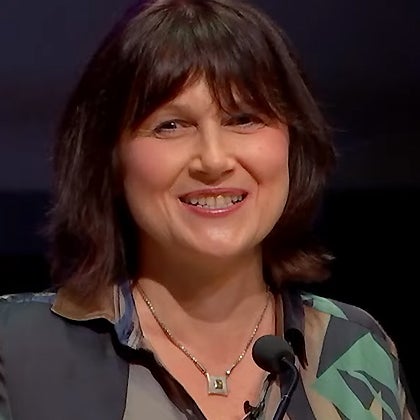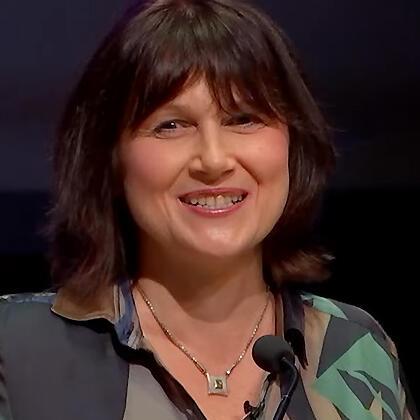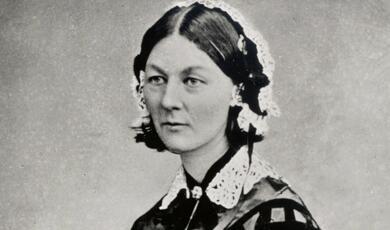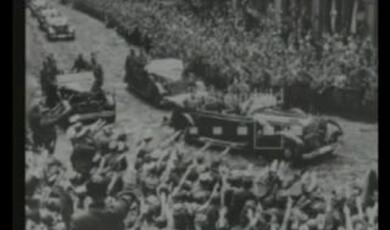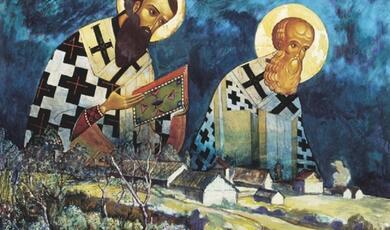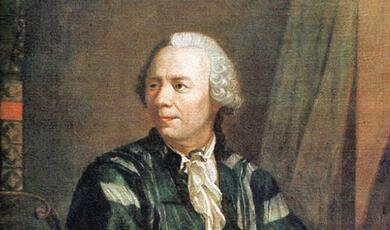Prokofiev the Soviet Artist
Share
- Details
- Transcript
- Audio
- Downloads
- Extra Reading
This lecture will follow the tortuous path of Prokofiev’s transformation into a Soviet artist. Prokofiev had pursued his career abroad and returned to (Soviet) Russia as a major international celebrity. Even though he was willing, in principle, to write “music for the people”, he found it very difficult to meet the precise demands of the state. Prokofiev was one of the most highly honoured Soviet artists, but he was still hounded into near silence towards the end of his life.
During the lecture, the Bodman String Quartet will perform Prokofiev's String Quartet No. 2:
Polina Makhina (violin)
Mila Ferramosca (violin)
Charles Whittaker (viola)
Laura Armstrong (cello)
Download Transcript
Prokofiev The Soviet Artist
Professor Marina Frolova-Walker
10th February 2022
Why Did He Return?
In 1918, at the age of 27, Prokofiev left Soviet Russia with official permission from Lunacharsky, who was the culture minister (the title was “Commissar for Enlightenment”). Prokofiev travelled eastwards, crossing Siberia and taking a boat to Japan. He eventually crossed the Pacific to the United States, where he supported himself by giving piano recitals. There, with the help of various Russian émigrés, he started building a career for himself as a composer-pianist, who specialised in playing his own virtuosic modernist pieces. From 1921 onwards, he made Paris his new base, but continued to tour widely, returning to the US several times (his concerts there were the most lucrative). He kept himself very busy, juggling composition and performance, while acting as his own manager and publishing agent. He earned himself an international reputation as a composer, but not on the level of Stravinsky, who outranked him in both prestige and earnings.
The Soviet authorities began to court Prokofiev in 1925, at the first opportunity, when post-Revolutionary life in Russia had reached a kind of equilibrium (they also contacted Rachmaninov and Stravinsky, to no avail). Within two years, Prokofiev was persuaded to make his first concert tour back in Russia. This was a resounding success, encouraging Prokofiev to repeat the experience several times over the next decade. By 1936, he made the decisive move of bringing his family with him to settle in Moscow. Unfortunately for him, this was just at the point when music was being placed under much tighter political control.
Music-lovers and scholars alike have long wondered why on earth he would choose to leave the glamour and freedom of Paris, then the world’s artistic capital, and exchange it all for a new life in Stalin’s Soviet Union. But what seems bizarre, on the face of it, actually had an array of reasons that were certainly not implausible at the time:
• he never considered his emigration permanent, and he avoided entanglement with anti-Soviet Russian émigré circles
•he never quite settled down in Paris – he never bought a house there
•he was swayed by the combination of intense wooing from the Soviet authorities and the adulation he received from the Russian public
•he could not have predicted that he would soon lose his right to travel back to the West, even if he realised that this was a possibility
•he was always indifferent to politics and observed global cataclysms with curiosity rather than with any deep emotional or moral involvement
•he was not alone: many Russian artists sought employment in the Soviet Union while opportunities in the rest of the world narrowed due to the Depression in the US, and when Europe was becoming riven with bitter division
•he believed (correctly) that in Russia he would be able to support himself as a composer, relieved of the strain of working as a full-time concert pianist
•he believed that since his style, although modernist, was founded on melody and tonal harmony, he could write “music for the people” and become the leader of Soviet music (rather than continue in the shadow of Stravinsky in the West)
In this lecture we will try to determine to what extent Prokofiev’s optimism was mistaken, and why his battle for official Soviet recognition cost him so much time and effort.
Grappling with the Soviet Style
Prokofiev tried to lay the groundwork for his Soviet career in 1932, when he began to tailor some of his music for his Soviet audience. One striking early example is his Symphonic Song of 1933, a twenty-minute-long orchestral piece that embodies the standard Soviet narrative, moving from darkness through struggle to light. Prokofiev most likely drew inspiration from Soviet pieces such as Shostakovich’s Second Symphony (“To October”), in which the goal of the narrative was made more explicit by the setting of revolutionary verses for chorus in the closing section. Prokofiev also clearly attempted to write in a lyrical style, although the work is purely instrumental: the “song” is symphonic, not literal. Even so, the result is hardly “music for the people”, since the piece is serious and demanding, with complex harmony and multi-layered textures.
When the piece was premiered in the Soviet Union in 1934 (still before Prokofiev’s final return), the reception was cold, with critical reviews that set out the problems in ideological terms:
“The principal mood of the Symphonic Song is fatigue and sickly despair. The musical material is so abstract that instead of concrete, living images, we are faced with melancholy, immaterial arabesques. The composer’s orchestral palette produces various pictures that are striking mainly for the gloomy elegiac background, against which lone melodies of solo instruments appear, as if lost in sound space, together with the dim sonorities of certain groups of instruments. The Symphonic Song is an elegy to solitude, its lyrical emotion is the emotion of social and cultural homelessness in a man who is disappointed by the present and is unable to believe in the future. It is on a par with the moods of the frustrated and weary urban lyricists of West today.”
Alexander Ostretsov (Sovetskaya muzïka, 1934)
Prokofiev’s most ambitious Soviet project of the 30s was his Cantata for the 20th Anniversary of the October Revolution. The piece had a lengthy gestation period, with the embryonic idea of setting quotations from Lenin to music, and here, Prokofiev was actually taking up the modernist challenge of setting words that would previously have been thought utterly unsuitable for musical presentation. The project then broadened to include quotations from the Marx and Engels of The Communist Manifesto, and finally, some extracts from Stalin’s speeches were added. In some of the Cantata’s numbers, such as the “Revolution” section, Prokofiev demonstrates his awareness of Soviet agitprop music from the 1920s, which he evokes in his use of choral and solo declamation, an extra group of four accordions, a siren, noise effects, and folk-like songs, all assembled in an Eisenstein-like cinematic montage (comparable to Mosolov’s Anti-Religious Symphonic Poem, which we discussed and heard during the first lecture of the present course).
By 1937, it was highly improper to set the “sacred texts” of Communism to music; the cult of Lenin and now of Stalin too had progressed so far that no composer could possibly measure up to the task. These words were even, in a sense, too sacred for study by the masses. The Short Course of the History of the Communist Party, published in 1938, became the proper source text for ordinary Soviet citizens who wanted to acquire the correct interpretation of the Marxist texts.
The Cantata was not performed at the Revolution’s anniversary celebrations in 1937, and there would be no performance of the work at all during the composer’s lifetime. Prokofiev tried to appeal to powerful patrons (one of them was Marshal Tukhachevsky, just because he was arrested). Like Shostakovich’s Fourth Symphony, it had to wait until the 1960s to be premiered. The words of Stalin, of course, had to be removed, since the former leader had been tactically disowned by the regime a decade earlier.
Once he had accepted the failure of this major project, Prokofiev changed tack and composed a much lighter cantata, a sequence of nine little songs (with orchestral accompaniment) on contemporary subjects, under the title Songs of Our Times. Prokofiev’s tone-deafness to the mainstream Socialist Realist style is quite staggering, not from any kind of rebelliousness of spirit, but rather from overweening self-assurance and a simple failure to observe his environment. It is instructive to compare one of these Prokofiev songs to a setting by a leading popular song writer of the time, Isaac Dunayevsky, whose setting was much more astute, and became well known, while Prokofiev’s was forgotten. Here is the text of the first verse:
“От края до края, по горным вершинам,
Где вольный орёл совершает полёт,
О Сталине мудром, родном и любимом,
Прекрасную песню слагает народ.”
“From border to border, over the summits,
Where a freewheeling eagle performs its flight,
The people construct a beautiful song
About Stalin the wise, our dearly beloved.”
Dunayevsky attains a degree of grandeur in the verse, while the chorus is a lively march, while Prokofiev gives us a modern version of Glinka’s “Travelling Song”: a buffo recitation with a graceful feminine melody in the middle. It seems that he pays no attention whatsoever to the register of the verses, which creates an almost comical effect (for example, on the line: “И мир угнетателей злобно дрожит» - Аnd the world of the oppressors trembles with rage”. Songs of Our Days were criticised for being too simplistic, almost primitive, and we might say with hindsight that the criticism could have been far, far worse.
Zdravitsa and the Cult of Stalin
The Stalin cult became pervasive across the arts in the mid-late 30s. In music, it became a persistent feature from 1936 onwards. One of the first notable contributions emerged in the festival of Ukrainian arts Moscow that year. This was one of a series of festivals of the national (i.e., non-Russian) republics, and each festival served as a report on cultural development of the republic in question, and also as an expression of loyalty and gratitude to the leadership of the Union. Each republic in turn would offer up its cultural harvest and in return, its artists would receive honorary titles, medals and valuable mementos. The Ukrainian composer Lev Revutsky became the musical pioneer of the cult in his “Song about Stalin”. Revutsky’s modest beginning was soon followed by further offerings that gradually grew in size and ambition, such as Khachaturyan’s Poem about Stalin, which is a 20-minute orchestral piece with a choral finale, written in a (supposedly) Armenian style.
In 1936 and 37 there was a campaign to elicit poems from around the Soviet Union about Lenin, Stalin and the building of socialism, which were all to be published in Russian translation. Today we know that this new folklore was largely “fakelore”, that the so-called translators were actually the authors, who cultivated a naïve style, and eulogised Stalin in terms that were embarrassingly exaggerated. But because these poems were presented as the spontaneous voice of the “liberated” peoples of the Union, Stalin could receive them with a benign, fatherly smile.
Such is the background to Prokofiev’s cantata Zdravitsa (variously translated as A Toast to Stalin or Hail to Stalin) composed in 1939 for Stalin’s 60th-birthday celebrations. Zdravitsa is a series of settings of just such fakelore verses, and Prokofiev provides each with a hint of national colour according to the republic that supposedly produced each poem. The disparate poems are framed by a majestic C-major theme which supplies the whole with the monumentality that the subject matter demanded. Unlike Prokofiev’s previous attempts at a Soviet style, Zdravitsa was well received, although the Composers’ Union did not nominate it for a Stalin Prize in 1941.
Zdravitsa has provoked much commentary in post-Soviet times, and many scholars believe that it must have been intended ironically, pointing to features of the score, such as the first appearance of Stalin’s name, which is sung to a tritone, an awkward interval for singers to pitch, and which is often labelled as “diabolical” (due to the modern misunderstanding of a light-hearted mediaeval mnemonic). The harmonisation at the same moment adds to the strangeness of the passage. This much is certainly true, but the interpretation of the passage as a deliberate grotesque intrusion to mock Stalin is speculative. However, there is nothing in Prokofiev’s biography or known character that would support such an interpretation. Moreover, Zdravitsa was written just after the effective banning of the 20th Anniversary Cantata, and it would have been the height of stupidity for Prokofiev to indulge in such mockery. How on earth would such pointless risk-taking square with his ambitions to become the Soviet Union’s leading composer? Unlike Shostakovich, there is no evidence of Prokofiev writing private musical satires about the regime. I would argue that such a passage flows from Prokofiev’s style of the time, which had absorbed various elements that might have sounded grotesque or distorted in the 1910s but were now simply his stock compositional devices. This view is further supported by the fact that Prokofiev tends to follow his own musical logic without detailed word painting (as in Songs of Our Time). What we can safely say is that Prokofiev would have been wiser to avoid anything that could draw accusations of grotesquerie at the mention of “Stalin”, but as it happens, no one picked him up on the faux pas.
Prokofiev’s Separate Trajectory
Soviet composers of the time experienced restrictions, certainly, but they also enjoyed substantial material benefits and security that the impoverished Russian émigrés understandably envied. Prokofiev, however, returned at a difficult time, with the official condemnation of Shostakovich’s Lady Macbeth, and then the arrests, labour-camp sentences and executions that cut a swathe through the intelligentsia. Many who had been abroad came under suspicion, but Prokofiev was not among them. Nor was he singled out for his music as Shostakovich was. He neither received special criticism nor special praise. In the years around 1940, it was as if he had been put in a decontamination chamber, and then forgotten. One official said of him that he had “not quite unpacked his suitcases”, and this feeling persisted. One problem was that his former role had disappeared: he had acted as an intermediary between the Soviet Union and the West, but after the Soviet state turned inwards, this was an irrelevance. Prokofiev attempted to capitalise on the pieces he had written in the West, such as the Third and Fourth Symphonies or the Fifth Piano Concerto, but these were greeted with no more than a bemused tolerance. He was unlucky with two commissions for incidental music in theatrical productions (Boris Godunov for Meyerhold, Eugene Onegin for Tairov); these came to nothing because of trouble that came down upon either the theatres or the directors in question.
Even his successes suffered from these peripheral problems. Prokofiev’s music for children was welcomed in the Soviet Union, and especially Peter and the Wolf. Unfortunately, Nataliya Sats, who had commissioned the piece for her unique Children’s Music Theatre, was arrested and sent to the camps shortly after the premiere. Prokofiev wrote a ground-breaking score for Sergei Eisenstein’s Alexander Nevsky, but the film was immediately shelved upon the signing of the Molotov-Ribbentrop pact, due to the obvious anti-German symbolism of the plot. For the same reason, performance of Prokofiev’s opera Semyon Kotko was delayed because of the German occupiers of the plot, but eventually they were relabelled as Austrians. He had hoped that Meyerhold would stage the opera, but then Meyerhold was arrested and disappeared off the scene (he was secretly executed several months later). His ballet Romeo and Juliet won fame through the orchestral suites that Prokofiev extracted from the score, but Soviet ballet theatres did not stage it for several years. When the premiere came, the choreographer and dancers received a Stalin Prize, but Prokofiev, bizarrely, was passed over.
It became clear that Prokofiev was being snubbed in the awards for the newly established Stalin Prizes. Prokofiev would have known that the Committee voted for his Alexander Nevsky to receive a prize alongside works by Shostakovich, Myaskovsky, Shaporin and Khachaturian, but when the results were published, his name was no longer on the list. He also failed to win the prize the following year, when his Quartet No. 2 was nominated. Prokofiev had composed the Quartet during his wartime evacuation to Nalchik, in the Caucasus mountains, and he went to the trouble of incorporating themes from the local culture in order to conform to the folk-based “narodnost’” that was a core feature of Socialist Realism (which Shostakovich had ignored, as I mentioned in an earlier lecture in the series).
The Quartet No.2
Precisely because Prokofiev valued his own melodic gift so highly, he rarely tapped into folk sources. The most notable example prior to the Quartet was his Overture on Hebrew Themes of 1919, which was a commission; here, he handled the klezmer style with great flair. In wartime Nalchik, where he was warmly welcomed by the local cultural authorities, he felt that it was appropriate to return the favour, hence the use of Kabardino-Balkar themes as the basis of the Quartet. There is an enormous quantity of pedestrian folksong arrangements or adaptations by Soviet composers, but among these, Prokofiev’s Quartet stands out for its boldness, and there is no sense that he felt restricted by the folk material. Inspired by the sounds of local instrumental ensembles, Prokofiev imitates their bowed, plucked and percussion sounds in spectacular fashion. The astringent harmonic style goes well beyond Khachaturian’s milder approach to the folk music of the same region and seems instead to draw from Manuel de Falla’s similar explorations of the Spanish idiom (such as his 1926 Concerto for harpsichord and ensemble).
We leave Prokofiev at this point, just as he is about to make his breakthrough to official favour, to continue the story in the course of the final lectures of the series.
© Professor Frolova-Walker 2022
References and Further Reading
Simon Morrison, The People’s Artist: Prokofiev’s Soviet Years (OUP, 2009)
Simon Morrison, The Love and Wars of Lina Prokofiev (Houghton Mifflin Harcourt, 2013)
Marina Frolova-Walker, “Stalin and the Art of Boredom”, Twentieth–Century Music (2004), 1 (1), 101-124
Marina Frolova-Uoker, 'Effekt prisutstviya: Prokof'yev v Rossii 1920-kh godov', S.S. Prokof'yev: K 125-letiyu so dnya rozhdeniya. Pis'ma, dokumentï, stat'yi, vospominaniya, ed. by Yekaterina Vlasova (Moscow: Kompozitor, 2016), 317-29
Vladimir Orlov, “Prokofiev and the Myth of the Father of Nations”, The Journal of Musicology, Vol. 30, No. 4 (Fall 2013), pp. 577-620
Rethinking Prokofiev, ed. by Rita McAllister and Christina Guillaumier (Oxford, 2020)
FYI: You can find three more of my Gresham lectures on Prokofiev here:
On his opera War and Peace: https://www.youtube.com/watch?v=Aquog9hoSAY
On his ballet The Prodigal Son: https://www.youtube.com/watch?v=ytfmv6Pl30s
On his piano music (with Peter Donohoe): https://www.youtube.com/watch?v=uQoSs7M4BJY
References and Further Reading
Simon Morrison, The People’s Artist: Prokofiev’s Soviet Years (OUP, 2009)
Simon Morrison, The Love and Wars of Lina Prokofiev (Houghton Mifflin Harcourt, 2013)
Marina Frolova-Walker, “Stalin and the Art of Boredom”, Twentieth–Century Music (2004), 1 (1), 101-124
Marina Frolova-Uoker, 'Effekt prisutstviya: Prokof'yev v Rossii 1920-kh godov', S.S. Prokof'yev: K 125-letiyu so dnya rozhdeniya. Pis'ma, dokumentï, stat'yi, vospominaniya, ed. by Yekaterina Vlasova (Moscow: Kompozitor, 2016), 317-29
Vladimir Orlov, “Prokofiev and the Myth of the Father of Nations”, The Journal of Musicology, Vol. 30, No. 4 (Fall 2013), pp. 577-620
Rethinking Prokofiev, ed. by Rita McAllister and Christina Guillaumier (Oxford, 2020)
FYI: You can find three more of my Gresham lectures on Prokofiev here:
On his opera War and Peace: https://www.youtube.com/watch?v=Aquog9hoSAY
On his ballet The Prodigal Son: https://www.youtube.com/watch?v=ytfmv6Pl30s
On his piano music (with Peter Donohoe): https://www.youtube.com/watch?v=uQoSs7M4BJY
Part of:
This event was on Thu, 10 Feb 2022
Support Gresham
Gresham College has offered an outstanding education to the public free of charge for over 400 years. Today, Gresham plays an important role in fostering a love of learning and a greater understanding of ourselves and the world around us. Your donation will help to widen our reach and to broaden our audience, allowing more people to benefit from a high-quality education from some of the brightest minds.


 Login
Login
